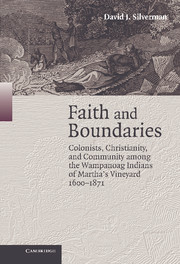 Faith and Boundaries
Faith and Boundaries Book contents
- Frontmatter
- Contents
- Maps, Tables, and Figures
- Abbreviations
- Preface: Do Good Walls Make Good Neighbors?
- Introduction: Epenow's Lessons
- 1 “Here Comes the Englishman”
- 2 To Become All Things to All Men
- 3 The Lord Tests the Righteous
- 4 Deposing the Sachem to Defend the Sachemship
- 5 Leading Values
- 6 The Costs of Debt
- 7 “Newcomers and Strangers”
- Conclusion: Fencing In, Fencing Out
- Appendix A The Population of Martha's Vineyard
- Appendix B A Cross-Comparison of Indian Race Descriptions
- Index
Conclusion: Fencing In, Fencing Out
Published online by Cambridge University Press: 17 December 2010
- Frontmatter
- Contents
- Maps, Tables, and Figures
- Abbreviations
- Preface: Do Good Walls Make Good Neighbors?
- Introduction: Epenow's Lessons
- 1 “Here Comes the Englishman”
- 2 To Become All Things to All Men
- 3 The Lord Tests the Righteous
- 4 Deposing the Sachem to Defend the Sachemship
- 5 Leading Values
- 6 The Costs of Debt
- 7 “Newcomers and Strangers”
- Conclusion: Fencing In, Fencing Out
- Appendix A The Population of Martha's Vineyard
- Appendix B A Cross-Comparison of Indian Race Descriptions
- Index
Summary
For centuries, the Wampanoags have related that in ancient days a giant named Moshup led their people to Noepe, or Martha's Vineyard, where he served as their benefactor. He provided them with gifts of whale meat, mediated their disputes, and instructed them on the importance of courtesy. But English colonization and the spread of Christianity brought Moshup's guardianship to an end. Unwilling to accept the waves of change washing over his island, the giant “retired in disgust,” never to appear again. The only sign of his lingering presence were deep fogs that supposedly rose from his pipe while he lay hidden in the cliffs of Aquinnah.
Moshup was a model for proper living, but Vineyard Wampanoags could hardly afford to mimic his retreat. The Indians, unlike their culture hero, were surrounded by the graves and spirits of ancestors, mnemonic devices for the people's stories, and familiar places for hunting, fishing, gathering, and planting that had fed countless generations. Martha's Vineyard was not just land but the homeland. Abandoning it would set the people adrift where, at best, they would suffer from cultural amnesia, and, at worst, risk starvation and vulnerability. Therefore, although Wampanoags often shared Moshup's revulsion for the English and suffered incredible pressure to follow him into exile, they made the hard compromises to persevere in their natal territory.
- Type
- Chapter
- Information
- Faith and BoundariesColonists, Christianity, and Community among the Wampanoag Indians of Martha's Vineyard, 1600–1871, pp. 274 - 284Publisher: Cambridge University PressPrint publication year: 2005
